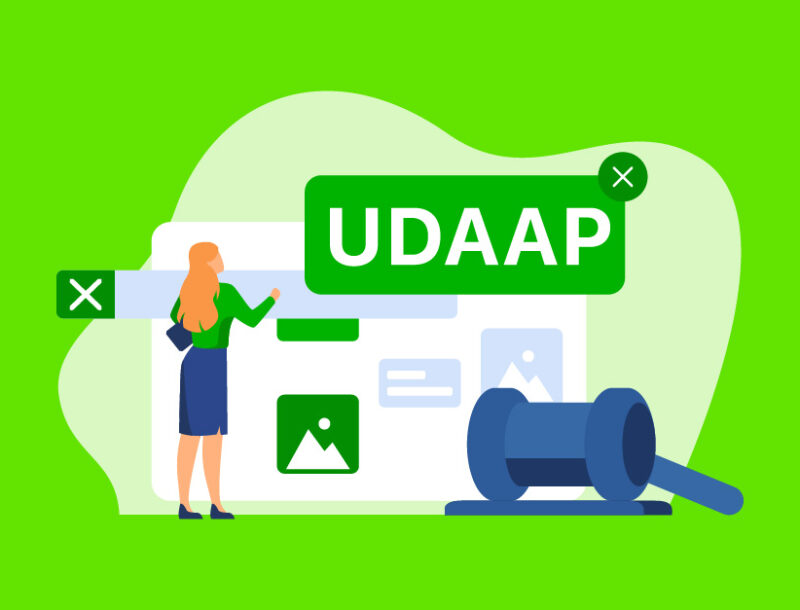5 Common UDAAP Compliance Violations + How to Stop Them
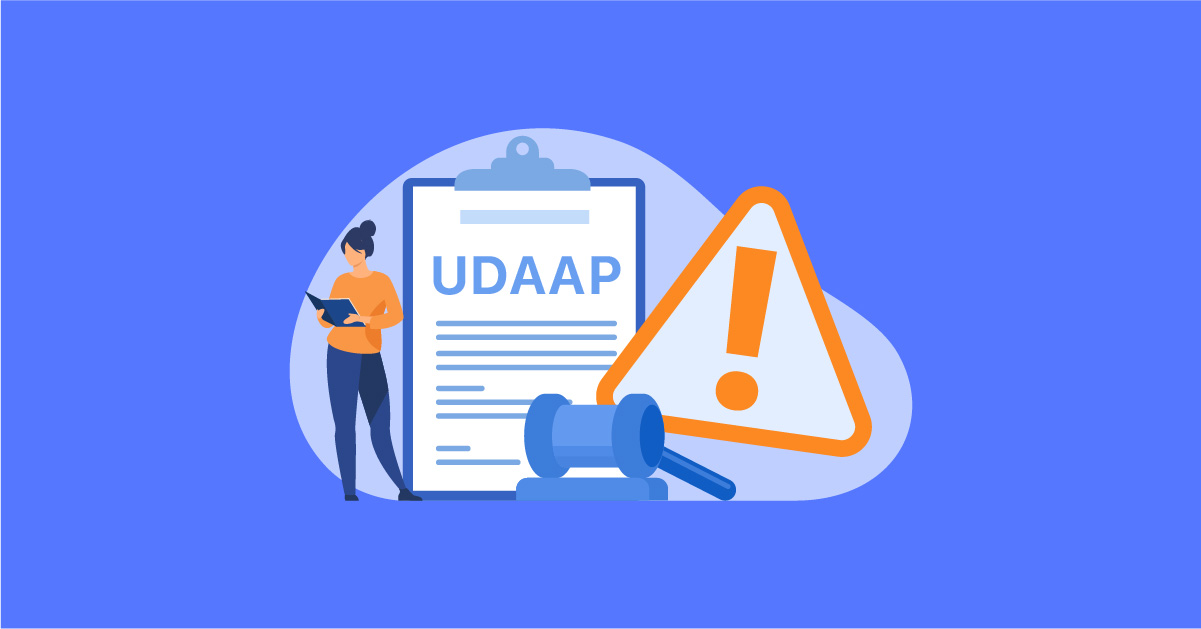
As regulatory scrutiny for Unfair, Deceptive, and Abusive Acts or Practices (UDAAP) continues to increase, ensuring compliance is crucial. In this blog post, we’ll explore five common UDAAP compliance violations—exaggerated claims, subjective language, no barrier to entry, false sense of urgency, and credit deception—and provide tips on how to avoid them.
Understanding these common UDAAP compliance violations will help you create marketing materials that are transparent and honest, ensuring that you provide your consumers with accurate information to make informed decisions.
Exaggerated Claims
What are exaggerated claims?
Exaggerated claims in marketing materials for financial products refer to statements that are not entirely truthful or accurate and are designed to make the product or service appear more attractive or valuable than it actually is.
Example of an exaggerated claim
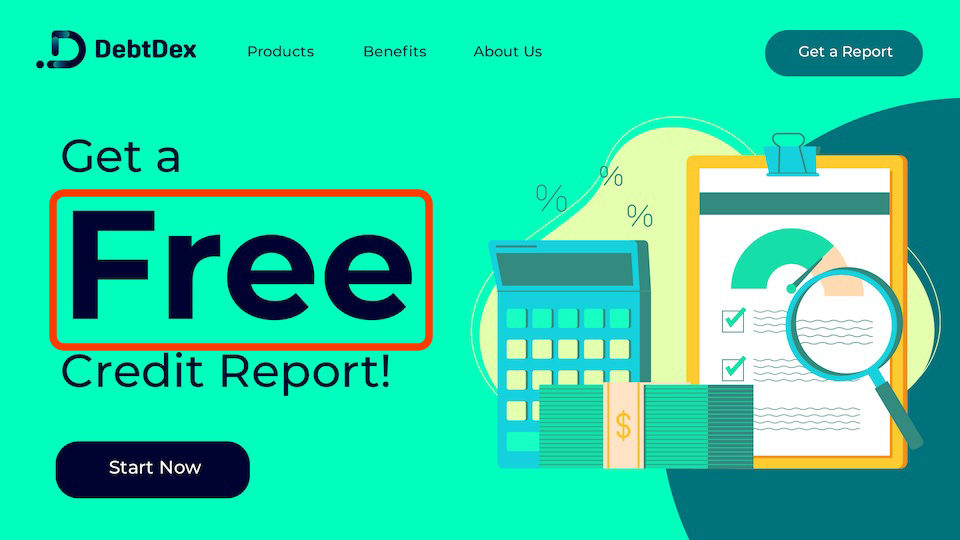
This website offers consumers a “free” credit report—but, they require the customer to sign up for a credit monitoring service with a monthly fee, making the report not actually free. This web page doesn’t clearly disclose that disclosure, which may deceptively lead to a consumer signing up without fully understanding the associated fees.
Why exaggerated claims are considered UDAAP violations
Marketing materials that make exaggerated claims about certain offers can be flagged as a UDAAP compliance violation because they create unrealistic expectations for consumers about the benefits or features of a financial product, leading them to make decisions based on false or misleading information.
While speaking about the benefits of a product or service isn’t necessarily prohibited, it should not be done so at the expense of the consumer’s understanding of what they’re signing up for.
Marketing materials must clearly disclose applicable fees, terms, and/or conditions associated with the offer to ensure that consumers have all the necessary information to make an informed decision.
Subjective Language
What is subjective language?
Subjective language is terms or phrases that are open to interpretation or opinion, can be vague or ambiguous, and do not have a clear or objective meaning.
Example of subjective language

This webpage is promoting its credit card as “the best” without any sort of substantiation or disclaimers, which is misleading because what’s best for one consumer might not be what’s best for another. This message also creates a false sense of superiority, which can pressure consumers into applying for the credit card without fully considering their options.
Why subjective language is considered a UDAAP violation
Marketing materials that use subjective language to lure consumers into using a particular product or service can lead to UDAAP compliance issues if there is no substantiation or disclosure to clarify the statement being made.
While using subjective language may be used to create an emotional response in the consumer, they do not provide any objective information about the product or service, leading them to make decisions based on emotion versus choosing the best product for their unique needs.
Using vague language that leaves the definition up to the interpretation of the consumer should be avoided. Marketing materials should aim to use clear and concise language and substantiate any claims to ensure that consumers aren’t misled and that they have all the necessary information to make their decision.
No Barrier to Entry
What is no barrier to entry?
“No barrier to entry” claims refer to statements or descriptions that imply that there are no obstacles or requirements for consumers to obtain or get approved for a particular financial product or service.
Example of no barrier to entry

In this example, the flyer promises consumers instant approval, but approval is based on the consumer’s credit history and can actually take anywhere from 2 to 5 days. Since the language on the flyer would reasonably lead a consumer to believe that they would get approved instantly, this could be considered a UDAAP violation.
Why no barrier to entry is considered a UDAAP violation
Marketing materials that use “no barrier to entry” terms and phrases can be flagged for a UDAAP violation because it gives consumers false or unrealistic expectations. This type of messaging is particularly abusive if the marketing campaigns target vulnerable consumers, such as those with low credit scores or financial difficulties.
Organizations should never promise any type of approval and should use clear and accurate language in their marketing materials to avoid setting false expectations for consumers. Any limitations or conditions associated with the product or service should be disclosed to provide consumers with a complete and transparent picture of the features and risks.
False sense of urgency
What is false sense of urgency?
False sense of urgency language is phrases or terms that create a sense of urgency or panic in potential customers that can lead to consumers making a decision before they have had the chance to fully consider their options. This language typically is not based on actual time-sensitive information or a genuine need to take action.
False sense of urgency language could also be terms or phrases that create unrealistic expectations for consumers on how quickly they can get approval or access to a specific product.
Example of false sense of urgency
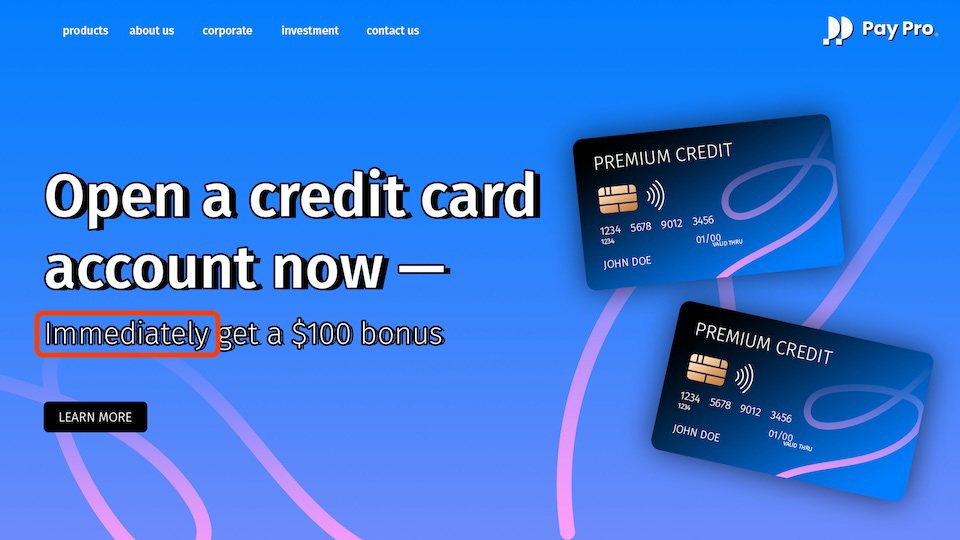
In this example, the language used may create a false sense of urgency and pressure on the consumer to make a quick decision, without considering the long-term consequences of opening a new credit card account. By offering an immediate $100 bonus, the marketing material encourages the consumer to focus on the short-term gain rather than the long-term costs and benefits of the credit card.
Why a false sense of urgency is considered a UDAAP violation
Because consumers can be misled and manipulated into making decisions that are not actually in their best interest, language that creates a false sense of urgency is considered a UDAAP violation.
Consumer finance companies should be cautious when using false sense of urgency language in their marketing materials and strive to be transparent and honest to provide consumers with clear and accurate information to help them make informed decisions.
Credit deception
What is credit deception?
Credit deception refers to terms or phrases within proximity to the word “credit” that might imply that the advertised product can positively influence or repair a consumer’s credit score or history more effectively than it actually can.
Example of credit deception
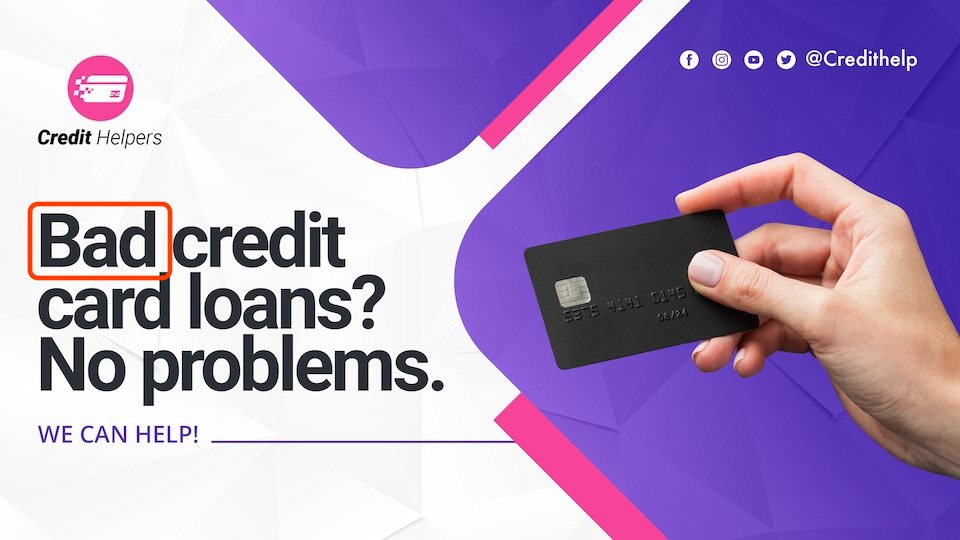
In this example, the web page targets consumers with “bad” credit and offers a seemingly easy solution. But, obtaining a car loan isn’t as easy as the landing page makes it out to be. Loans are still subject to approval, but consumers can easily be misled into believing they can get approved easily and quickly fix their bad credit with a loan.
Why credit deception is considered a UDAAP violation
Credit deception language can lead to UDAAP compliance violations because it can lead consumers
to believe that a product or service has certain financial benefits or capabilities that it does not
actually have, potentially leading them to make poorly informed financial decisions based on these
deceptive claims.
How to avoid common UDAAP compliance violations
A few steps that you can take to avoid common UDAAP compliance violations in your marketing materials include:
- Develop clear guidelines for marketing and advertising materials that outline what types of language are acceptable and what types are not
- Conduct thorough reviews of marketing materials prior to publication to ensure that all claims made in the materials are truthful and accurate and are free of any UDAAP violations outlined in the above sections
- Have ongoing compliance monitoring of all marketing materials post-publication for any terms or phrases that may indicate a UDAAP compliance issue
- Train employees on UDAAP compliance requirements that include what constitutes a UDAAP compliance violation, examples, and the potential consequences of violating compliance requirements
Bonus content: Get the free UDAAP compliance checklist
Mitigate UDAAP Risk with PerformLine
PerformLine is the only technology that provides an omni-channel compliance solution across six marketing channels, including the web, calls, emails, messages, documents, and social media.
This proprietary technology, paired with ready-to-use and expertly-crafted UDAAP rulebooks, takes the guesswork out of compliance and provides a solution that’s automated, efficient, and scalable.
Schedule a demo today to learn how PerformLine can help your organization find and remediate these common UDAAP compliance violations and more.
